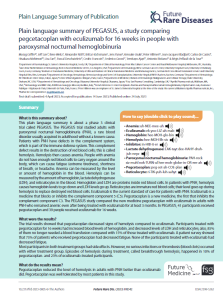Plain Language Summary: the PEGASUS study comparing pegcetacoplan with eculizumab for 16 weeks in people with paroxysmal nocturnal hemoglobinuria
 This Plain Language Summary of Publication article from Future Rare Diseases looks at a new medication called pegcetacoplan in the treatment of a rare blood disorder called paroxysmal nocturnal hemoglobinuria (PNH).
This Plain Language Summary of Publication article from Future Rare Diseases looks at a new medication called pegcetacoplan in the treatment of a rare blood disorder called paroxysmal nocturnal hemoglobinuria (PNH).
You can read the full article here.
The original article on which this summary is based is called ‘Pegcetacoplan versus Eculizumab in Paroxysmal Nocturnal Hemoglobinuria’ and was published in The New England Journal of Medicine.
You can read the original article here.
